Ojai's Cluff Vista Park Riparian Garden
Created 29 January 2006
This page last updated 1 February 2006
This page focuses on the Riparian Garden component of Cluff Vista Park. Riparian is Latin for "streamside". So when we talk about riparian habitats, we are referring to those areas on the banks of streams and rivers. Riparian habitats are common; however, this type of wetland has been greatly impacted by humans as the result of urban development, agriculture, and sand & gravel mining. Over 90 percent of the wetland habitats in California have been eliminated since the 1850s as a result of these land uses.
Like many of the smaller, and even large streams of the Ojai Valley and southern California, our streams, particularly those in the lowlands, are ephemeral. That is, they have flowing water only seasonally. However, the groundwater may be quite shallow, and available to those plants that either can send their roots down to the water table (which are called phraetophytic plants) or can survive the dry spells. The driving force behind the geomorphology of riparian and stream habitats is flood events. Flooding causes erosion and sediment deposition, and the plants that grow in such habitats must be adapted to the dynamics of too much water and scouring forces, and periods of not enough surface water, and a general lack of soil. Lack of soil, because the rocks, cobbles, gravels, sands, silts, and clays that are found in streambeds are considered too young, too recent, to have developed into true soils. The Riparian Garden at Cluff Vista Park contains rounded boulders and cobbles as often found along some of our smaller streams, vegetated with plants typcial for the region. The vegetation along our streams serve important functions, including: providing habitat for wildlife, shade for aquatic life, nutrient cycling, and streambank erosion control, to name a few. Removing riparian vegetation will result in a degraded habitat and cause degradation of downstream resources.

Above is a close-up of the park plan that shows the Riparian Garden, between the two fountain pools. Remember that the plan drawing is not exactly how the park was finally built, but it is very close.
CounterData.com

thalasso pornic Counter
All photos copyrighted by David L. Magney 2005-2006
Links to Additional Cluff Vista Park webpages
Cluff Vista Park Home Page
Cluff Vista Park Trellised Arbors Page
Cluff Vista Park Fountains Page
Cluff Vista Park Deergrass Meadow Page
Cluff Vista Park Other Features Page
Scenes of Riparian Garden at Cluff Vista Park
The Riparian Garden, representitive of a streamside habitat, complete with Narrowleaf Willow (Salix exigua), Arroyo Willow (Salix lasiolepis), a rush (Juncus sp.), California Fuchsia (Zauschneria californica), Scarlet Monkeyflower (Mimulus cardinale), and others. The streambed is represented by river cobbles and small boulders, and even has a homeless person sleeping under the brush once in a while, just like in the real world.
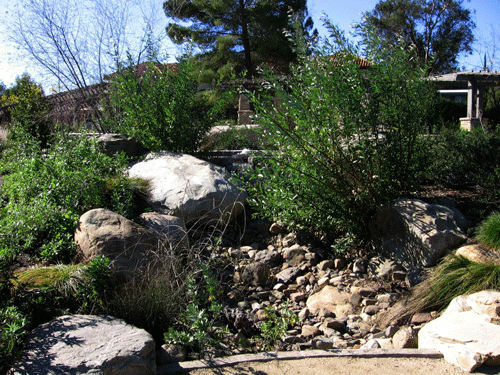
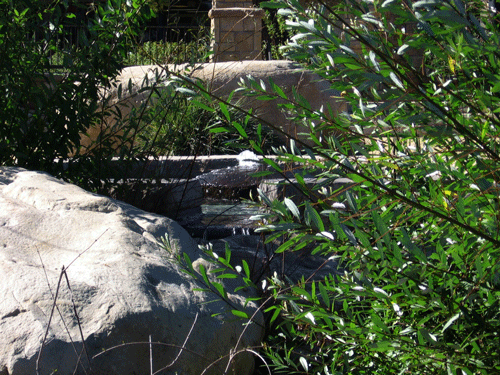
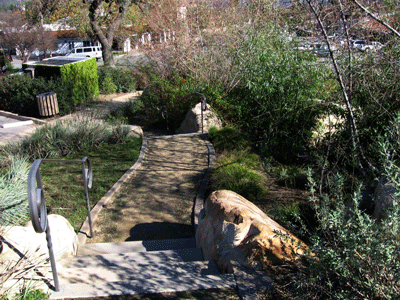
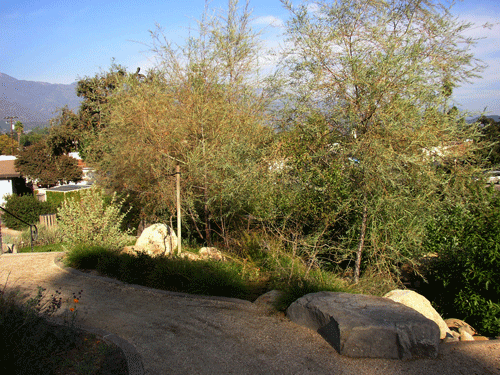
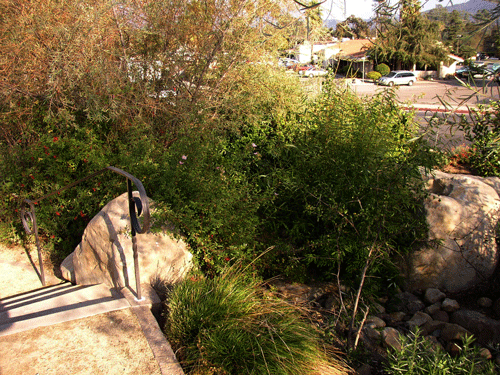
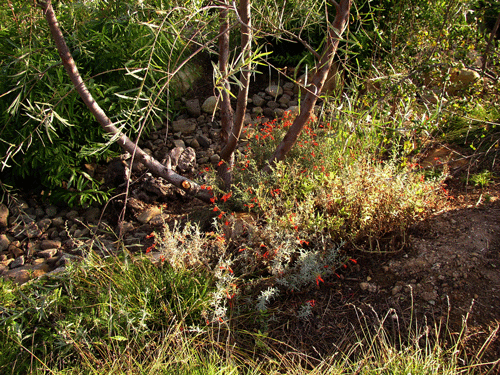
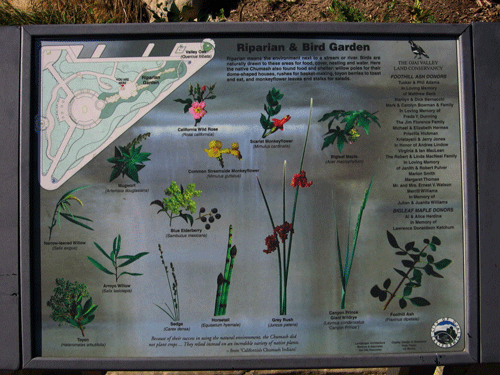 The interpretive sign for the Riparian & Bird gardens provides some very basic information about riparian habitats, and identifies some of the riparian plants found at Cluff Vista Park.
The interpretive sign for the Riparian & Bird gardens provides some very basic information about riparian habitats, and identifies some of the riparian plants found at Cluff Vista Park.
California Wild Rose (Rosa californica) rose hips and soft pink flowers offer nice color and greenery, and is a part of the Riparian Garden, as California Wild Rose is typically found along our streams in the wild. The rose hips are quite high in Vitamin C.
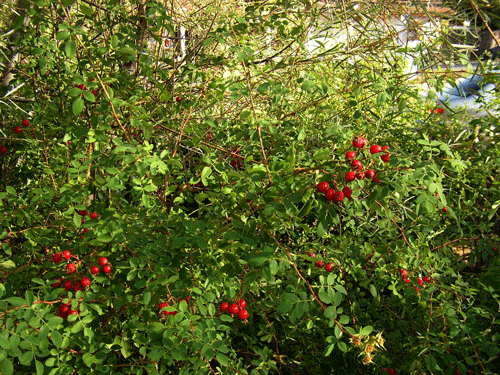
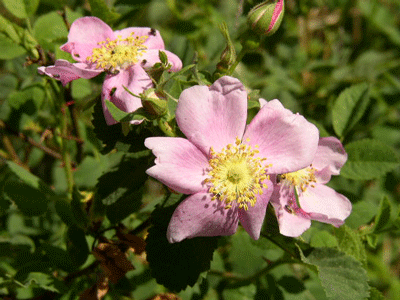
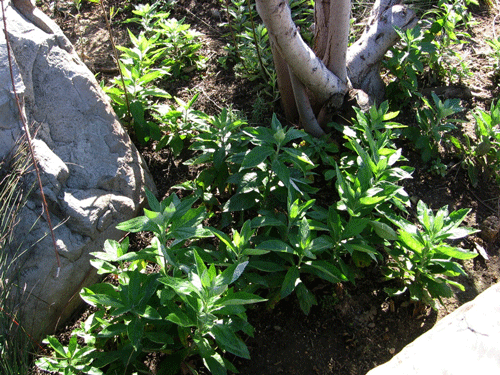 Mugwort (Artemisia douglasiana) is a common riparian perennial herb. It is a member of the Sunflower family (Asteraceae) and is said to be helpful in preventing a Poison Oak rash, or reducing the itchiness of it, by crushing the leaves and wiping the juice on the infected areas. This plant is wind pollinated and therefore does not need, or have, showy flowers. The leaves are bicolored: dark green on top and whitish beneath.
Mugwort (Artemisia douglasiana) is a common riparian perennial herb. It is a member of the Sunflower family (Asteraceae) and is said to be helpful in preventing a Poison Oak rash, or reducing the itchiness of it, by crushing the leaves and wiping the juice on the infected areas. This plant is wind pollinated and therefore does not need, or have, showy flowers. The leaves are bicolored: dark green on top and whitish beneath.
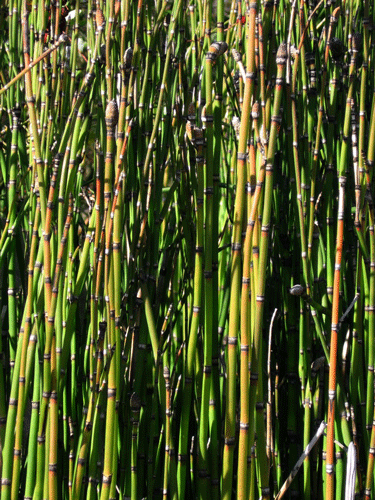 Next to the Moon Pond is a thicket of Common Horsetail (Equisetum arvense), which is found around pools and long streams. This ancient group of plants were tall trees during the Cretaceous, when dinosaurs ruled the Earth. The stems are very high in silica, which is abrasive and strong, and the pioneers used them to scour pots and pans clean. This plant is sometimes called Scouring Rush.
Next to the Moon Pond is a thicket of Common Horsetail (Equisetum arvense), which is found around pools and long streams. This ancient group of plants were tall trees during the Cretaceous, when dinosaurs ruled the Earth. The stems are very high in silica, which is abrasive and strong, and the pioneers used them to scour pots and pans clean. This plant is sometimes called Scouring Rush.
Previous Page |
Next Page
Cluff Vista Park Home Page
Ojai Area Home
Photography Home Page
Photography Site Map
DMEC Home







 The interpretive sign for the Riparian & Bird gardens provides some very basic information about riparian habitats, and identifies some of the riparian plants found at Cluff Vista Park.
The interpretive sign for the Riparian & Bird gardens provides some very basic information about riparian habitats, and identifies some of the riparian plants found at Cluff Vista Park.

 Mugwort (Artemisia douglasiana) is a common riparian perennial herb. It is a member of the Sunflower family (Asteraceae) and is said to be helpful in preventing a Poison Oak rash, or reducing the itchiness of it, by crushing the leaves and wiping the juice on the infected areas. This plant is wind pollinated and therefore does not need, or have, showy flowers. The leaves are bicolored: dark green on top and whitish beneath.
Mugwort (Artemisia douglasiana) is a common riparian perennial herb. It is a member of the Sunflower family (Asteraceae) and is said to be helpful in preventing a Poison Oak rash, or reducing the itchiness of it, by crushing the leaves and wiping the juice on the infected areas. This plant is wind pollinated and therefore does not need, or have, showy flowers. The leaves are bicolored: dark green on top and whitish beneath.
 Next to the Moon Pond is a thicket of Common Horsetail (Equisetum arvense), which is found around pools and long streams. This ancient group of plants were tall trees during the Cretaceous, when dinosaurs ruled the Earth. The stems are very high in silica, which is abrasive and strong, and the pioneers used them to scour pots and pans clean. This plant is sometimes called Scouring Rush.
Next to the Moon Pond is a thicket of Common Horsetail (Equisetum arvense), which is found around pools and long streams. This ancient group of plants were tall trees during the Cretaceous, when dinosaurs ruled the Earth. The stems are very high in silica, which is abrasive and strong, and the pioneers used them to scour pots and pans clean. This plant is sometimes called Scouring Rush.